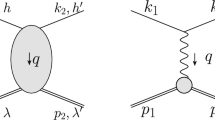Abstract
Recent data from high-statistics experiments that have measured the modulus of the pion electromagnetic form factor from threshold to relatively high energies are used as input in a suitable mathematical framework of analytic continuation to find stringent constraints on the shape parameters of the form factor at t=0. The method uses also as input a precise description of the phase of the form factor in the elastic region based on Fermi–Watson theorem and the analysis of the ππ scattering amplitude with dispersive Roy equations, and some information on the spacelike region coming from recent high precision experiments. Our analysis confirms the inconsistencies of several data on the modulus, especially from low energies, with analyticity and the input phase, noted in our earlier work. Using the data on the modulus from energies above 0.65 GeV, we obtain, with no specific parametrisation, the prediction \(\langle r_{\pi}^{2} \rangle\in(0.42,\,0.44)\ \text{fm}^{2}\) for the charge radius. The same formalism leads also to very narrow allowed ranges for the higher-order shape parameters at t=0, with a strong correlation among them.








Similar content being viewed by others
Notes
References
S.R. Amendolia et al. (NA7 Collaboration), Nucl. Phys. B 277, 168 (1986)
C.N. Brown, C.R. Canizares, W.E. Cooper, A.M. Eisner, G.J. Feldmann, C.A. Lichtenstein, L. Litt, W. Loceretz, V.B. Montana, F.M. Pipkin, Phys. Rev. D 8, 92 (1973)
C.J. Bebek et al., Phys. Rev. D 17, 1693 (1978)
T. Horn et al. (Jefferson Lab F(pi)-2 Collaboration), Phys. Rev. Lett. 97, 192001 (2006). nucl-ex/0607005
G.M. Huber et al. (Jefferson Lab Collaboration), Phys. Rev. C 78, 045203 (2008). 0809.3052 [nucl-ex]
B. Aubert et al. (BABAR Collaboration), Phys. Rev. Lett. 103, 231801 (2009). 0908.3589 [hep-ex]
F. Ambrosino et al. (KLOE Collaboration), Phys. Lett. B 670, 285 (2009). 0809.3950 [hep-ex]
F. Ambrosino et al. (KLOE Collaboration), Phys. Lett. B 700, 102 (2011). 1006.5313 [hep-ex]
R.R. Akhmetshin et al. (CMD-2 Collaboration), JETP Lett. 84, 413 (2006) [Pis’ma Zh. Eksp. Teor. Fiz., 84, 491 (2006)]. hep-ex/0610016
R.R. Akhmetshin et al. (CMD-2 Collaboration), Phys. Lett. B 648, 28 (2007). hep-ex/0610021
M. Fujikawa et al. (Belle Collaboration), Phys. Rev. D 78, 072006 (2008). 0805.3773 [hep-ex]
B. Ananthanarayan, G. Colangelo, J. Gasser, H. Leutwyler, Phys. Rep. 353, 207 (2001). hep-ph/0005297
G. Colangelo, J. Gasser, H. Leutwyler, Nucl. Phys. B 603, 125 (2001). hep-ph/0103088
I. Caprini, G. Colangelo, H. Leutwyler, Eur. Phys. J. C 72, 1860 (2012). 1111.7160 [hep-ph]
R. Kaminski, J.R. Pelaez, F.J. Yndurain, Phys. Rev. D 77, 054015 (2008). 0710.1150 [hep-ph]
R. Garcia-Martin, R. Kaminski, J.R. Pelaez, J. Ruiz de Elvira, F.J. Yndurain, Phys. Rev. D 83, 074004 (2011). 1102.2183 [hep-ph]
S. Ciulli, C. Pomponiu, I. Sabba-Stefanescu, Phys. Rep. 17, 133 (1975)
G. Abbas, B. Ananthanarayan, I. Caprini, I.S. Imsong, S. Ramanan, Eur. Phys. J. A 45, 389 (2010). 1004.4257 [hep-ph]
I. Caprini, Eur. Phys. J. C 13, 471 (2000). hep-ph/9907227
B. Ananthanarayan, I. Caprini, I.S. Imsong, Phys. Rev. D 83, 096002 (2011). 1102.3299 [hep-ph]
B. Ananthanarayan, I. Caprini, I.S. Imsong, Phys. Rev. D 85, 096006 (2012). 1203.5398 [hep-ph]
B. Ananthanarayan, I. Caprini, D. Das, I.S. Imsong, Eur. Phys. J. C 72, 2192 (2012). 1209.0379 [hep-ph]
G. Colangelo, M. Finkemeier, R. Urech, Phys. Rev. D 54, 4403 (1996). hep-ph/9604279
J. Bijnens, G. Colangelo, P. Talavera, J. High Energy Phys. 9805, 014 (1998). hep-ph/9805389
J. Bijnens, P. Talavera, J. High Energy Phys. 0203, 046 (2002). hep-ph/0203049
P. Maris, P.C. Tandy, Phys. Rev. C 61, 045202 (2000). nucl-th/9910033
S. Aoki et al. (JLQCD Collaboration TWQCD Collaboration), Phys. Rev. D 80, 034508 (2009). 0905.2465 [hep-lat]
J.F. de Troconiz, F.J. Yndurain, Phys. Rev. D 71, 073008 (2005). hep-ph/0402285
P. Masjuan, S. Peris, J.J. Sanz-Cillero, Phys. Rev. D 78, 074028 (2008). 0807.4893 [hep-ph]
T.N. Truong. hep-ph/9809476
R. Barate et al. (ALEPH Collaboration), Z. Phys. C 76, 15 (1997)
G.J. Gounaris, J.J. Sakurai, Phys. Rev. Lett. 21, 244 (1968)
N.N. Meiman, Sov. Phys. JETP 17, 830 (1963)
P. Duren, Theory of H p Spaces (Academic Press, New York, 1970)
S. Anderson et al. (CLEO Collaboration), Phys. Rev. D 61, 112002 (2000). hep-ex/9910046
H. Leutwyler. hep-ph/0212324
C. Hanhart, Phys. Lett. B 715, 170 (2012). 1203.6839 [hep-ph]
Acknowledgements
IC acknowledges support from the Program Nucleu under Contract PN 09370102/2009, and from Program Idei-PCE, Contract No 121/2011. ISS acknowledges the support from Deutsche Forschungsgemeinschaft Research Unit FOR 1873 “Quark Flavour Physics and Effective Theories”, Contract No. KH 205/2-1.
Author information
Authors and Affiliations
Corresponding author
Rights and permissions
About this article
Cite this article
Ananthanarayan, B., Caprini, I., Das, D. et al. Parametrisation-free determination of the shape parameters for the pion electromagnetic form factor. Eur. Phys. J. C 73, 2520 (2013). https://doi.org/10.1140/epjc/s10052-013-2520-9
Received:
Revised:
Published:
DOI: https://doi.org/10.1140/epjc/s10052-013-2520-9




